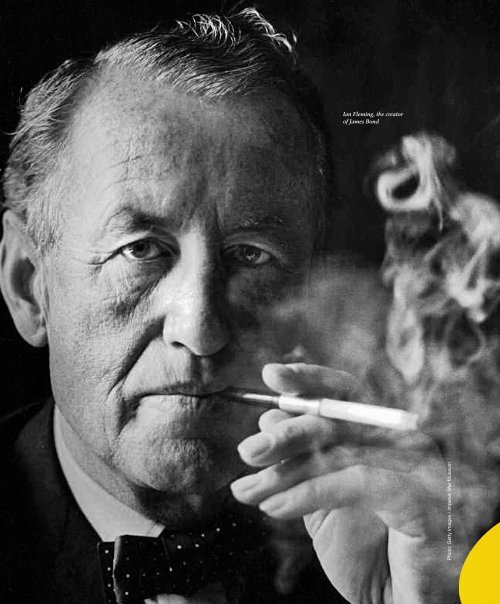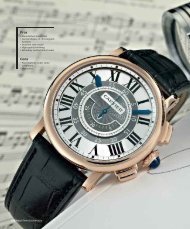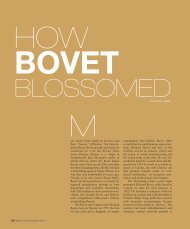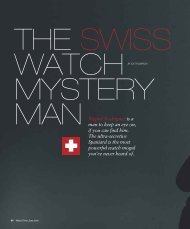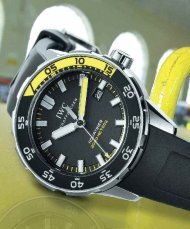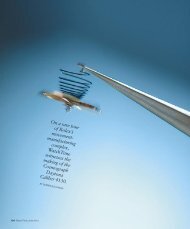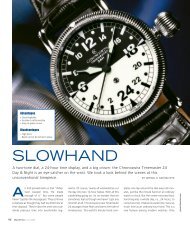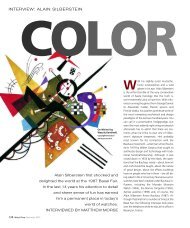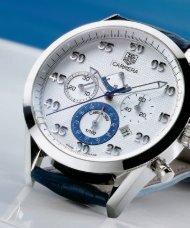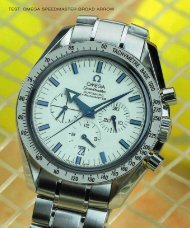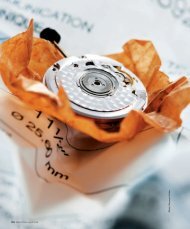WT_2009_01: MAN AND HIS WATCH: IAN FLEMING´S ROLEX ...
WT_2009_01: MAN AND HIS WATCH: IAN FLEMING´S ROLEX ...
WT_2009_01: MAN AND HIS WATCH: IAN FLEMING´S ROLEX ...
You also want an ePaper? Increase the reach of your titles
YUMPU automatically turns print PDFs into web optimized ePapers that Google loves.
Ian Fleming, the creator<br />
of James Bond<br />
Photo: Getty Images / Imperial War Museum
FOUND:<br />
JAMES BOND’S<br />
<strong>ROLEX</strong><br />
James Bond, like his creator Ian Fleming,<br />
wore a Rolex Explorer I.<br />
BY DELL DEATON
<strong>MAN</strong> <strong>AND</strong> <strong>HIS</strong> <strong>WATCH</strong><br />
Ian Fleming’s Rolex Explorer I<br />
Did<br />
Ian Fleming, the creator of James Bond, have a particular<br />
wristwatch in mind when writing the original 007 stories? Could<br />
it be that Fleming himself wore the first James Bond timepiece?<br />
Only one brand is specifically named as that secret agent’s<br />
watch in Fleming’s original 14 Bond editions: Rolex. The greatest<br />
detail comes in his eleventh book, On Her Majesty’s Secret<br />
Service, published in 1963. Here we read of the “big luminous<br />
numerals” that Bond sees when taking a lazy midnight glance at<br />
his chronometer, “a heavy Rolex Oyster Perpetual on an expanding<br />
metal bracelet.” The watch is a Rolex Explorer I.<br />
And not just any Rolex Explorer I. My research convinces<br />
me that it was Fleming’s own stainless-steel wristwatch, model<br />
1<strong>01</strong>6 with a black dial on a 7206 bracelet, case number 596851.<br />
Fleming’s stepdaughter, Fionn Morgan, believes it is the first and<br />
only Rolex he ever owned. After her stepfather passed away on<br />
August 12, 1964, the watch was locked in a bank vault. There it<br />
stayed until the death of her mother — his widow, Ann — in<br />
1981. That was when, following almost 20 years in isolation, it<br />
once again saw the light of day.<br />
“Spookily, it was still going,” Morgan said to me last May,<br />
recalling the day she first picked it up. “I am told that this happens<br />
with Oyster Perpetuals; your hand sets them off.” To her<br />
the watch was intensely personal, a family heirloom left by a<br />
man she loved as if her own blood-relation father. So she did<br />
what many of us would do. She gave it to her son-in-law, to<br />
wear daily as a touchstone with her past.<br />
That’s how it went until preparations began for the “Ian<br />
Fleming Centenary,” a year-plus celebration associated with the<br />
author’s 100th birthday on May 28, 2008. In particular,<br />
Britain’s Imperial War Museum (IWM) was planning a special<br />
45-week exhibition titled, “For Your Eyes Only: Ian Fleming<br />
and James Bond.” Mary Gibson, Fionn Morgan’s daughter,<br />
loaned for show the Ian Fleming watch that her husband had<br />
been wearing. Along with other Fleming artifacts and props<br />
from James Bond movies, the watch is on display at the museum<br />
in London until March 1, <strong>2009</strong>.<br />
The IWM exhibit asks a question often debated by Fleming<br />
biographers: How much of James Bond was Ian Fleming? Evidence<br />
abounds that Fleming steeped this fictional spy with his<br />
most personal tastes and habits. The 007 clothing choices, hatred<br />
of tea, and number of cigarettes smoked in a day all parallel<br />
aspects of Fleming’s own life.<br />
Product placements abound in his books. Familiar brands<br />
hook us to Bond’s world through the reality of what we already<br />
know and accept. Bond’s creator was thoughtful in the use of<br />
these. Thus there are obvious distinctions between references<br />
made to things he had simply researched to fill in gaps, and those<br />
he experienced personally.<br />
IN TOTAL, there are approximately 100 references to James<br />
Bond wearing a watch in the Fleming novels and short-story collections<br />
published between 1953 and 1966 (the last two were<br />
posthumous). Two-thirds of these tell readers nothing more<br />
than the time of day. This is particularly true in earlier novels<br />
such as Moonraker, Diamonds Are Forever, and Goldfinger,<br />
where Agent 007 mostly just looks or glances at his watch, on<br />
average nine to 10 times per story.<br />
Function and design details come slowly. We hear Bond’s<br />
watch “tick” for the first time in 1955. In 1957, we are told<br />
that, although he otherwise sleeps naked, Bond wears a watch<br />
to bed. Fleming used the word “glass” when referring to its crystal<br />
in From Russia, with Love. For Doctor No a dial is not just<br />
“luminous,” but blazingly so! In 1960, 007’s eyes follow “the<br />
gleaming minute-hand” creeping past its time markers.<br />
The Ian Fleming thrillers feature multiple James Bond<br />
watches. Bond loses his watch during the Casino Royale torture,<br />
has another watch shot apart on his wrist in From Russia,<br />
with Love, destroys a Rolex while using it as a “knuckle-duster”<br />
in On Her Majesty’s Secret Service, and is unlikely to have returned<br />
for whatever timepiece he left behind when Tiger Tanaka<br />
gives him a “cheap Japanese wristwatch” for his final pursuit<br />
of recurring arch-villain Blofeld in You Only Live Twice.<br />
Fleming, too, had many watches. Photographs from the<br />
1950s show him variously wearing a half-dozen-or-so nondescript<br />
wristwatches, mostly on straps. None stands out. This<br />
parallels the attitude of his character through the period as well.<br />
“I HAVE DISCUSSED T<strong>HIS</strong> WITH [JAMES BOND] <strong>AND</strong><br />
HE POINTS OUT THAT THE <strong>ROLEX</strong> PERPETUAL<br />
WEIGHS SIX OUNCES <strong>AND</strong> WOULD APPRECIABLY<br />
SLOW UP THE USE OF <strong>HIS</strong> LEFT H<strong>AND</strong> IN COMBAT.”<br />
<strong>IAN</strong> FLEMING IN A LETTER TO A READER<br />
86 WatchTime February <strong>2009</strong>
PHOTO: GETTY IMAGES<br />
I don’t suggest that Fleming treated his own watches as disposable<br />
(as his alter-ego certainly does). But Fleming heirs told me<br />
last summer that his Explorer I is the only wristwatch known to<br />
have survived him.<br />
Some Bond aficionados insist that Rolex is established as the<br />
definitive “James Bond watch” in Live and Let Die (1954). I<br />
don’t think so. When Fleming settled on a brand, he tended to<br />
either repeat it or clearly label its replacement. We don’t simply<br />
read about locks, we read about Yale locks, again and again, in<br />
multiple novels. James Bond drives a Bentley or an Aston Martin<br />
or a Thunderbird, a specific car, as opposed to any car we<br />
might imagine.<br />
That’s not the case with the 1954 Rolex. After Live and Let<br />
Die, almost a decade passed before Fleming gave Bond another<br />
Rolex. In the meantime, Fleming hadn’t forgotten the brand,<br />
since “a solid gold Rolex Oyster Perpetual Chronometer on a<br />
flexible gold bracelet” features prominently as a bad guy’s<br />
watch seven novels later, in Thunderball. (This Rolex becomes a<br />
“James Bond watch” of sorts, since Agent 007 puts it on his<br />
Ian Fleming at work in his study at Goldeneye, his home<br />
in Jamaica. On his wrist is his Rolex Explorer I.<br />
February <strong>2009</strong> WatchTime 87
<strong>MAN</strong> <strong>AND</strong> <strong>HIS</strong> <strong>WATCH</strong><br />
Ian Fleming’s Rolex Explorer I<br />
own wrist after removing it from the villain’s dead body.)<br />
Secondly, the Live and Let Die Rolex is a divers’ watch;<br />
hardly what men wore daily in the 1950s. We know how Bond’s<br />
watch had to perform here, because he “looked at the Rolex on<br />
his wrist” while underwater. He was at the close of a 300-yard<br />
dive in Jamaican waters, on a well-prepared mission to place<br />
mines on a smuggling vessel, moored at an anchorage of about<br />
30 feet. His agency quartermaster, Q Branch, has supplied him<br />
with a wetsuit and other special-purpose equipment for the assignment.<br />
It’s likely that Q had provided this particular watch as<br />
well, and that Bond did not choose the Live and Let Die Rolex<br />
for himself. (Years later, in On Her Majesty’s Secret Service, we<br />
learn that Q Branch actually keeps an off-the-shelf inventory of<br />
Rolex wristwatches, or at least came to do so by 1963.) For Live<br />
and Let Die, I think the plot simply called for 007 to check his<br />
watch in mid-swim in order to build tension at a key point in the<br />
exposition. As a diver himself, Fleming knew that a typical<br />
wristwatch was unsuitable; he needed to cite a specific brand to<br />
make that awareness clear. Being an accomplished journalist, he<br />
would have researched options.<br />
Finally, the lack of any further specifics on this Rolex, and<br />
no reference whatsoever to the brand in his next eight books,<br />
classify it as a watch Fleming researched rather than experienced.<br />
Most likely, he chose Rolex because of its advertising,<br />
which emphasized waterproof case integrity.<br />
This is more than speculation. In a letter he wrote four years after<br />
completing his Live and Let Die manuscript, Fleming made it<br />
clear that Rolex was not at that time James Bond’s choice for a<br />
Rolex: James Bond’s Secret Weapon<br />
Illustrator John McLusky was the first to<br />
provide a visual interpretation of what he<br />
thought Ian Fleming had intended for the<br />
007 Rolex in On Her Majesty’s Secret<br />
Service. McLusky helped create a “James<br />
Bond” comic strip, adapted from Ian<br />
Fleming’s novels and short stories, for<br />
Britain’s Daily Express from 1958 to 1966.<br />
The Bond Rolex appears in installment<br />
144 of the series in 1964. Unfortunately,<br />
these drawings came after Fleming’s<br />
death, so McLusky did not have the<br />
author’s input regarding wristwatch<br />
specifics.<br />
Still, it’s interesting that McLusky<br />
depicted the watch with<br />
luminescent numbers at 6,<br />
9, and 12, along with a<br />
signature Rolex date magnifier.<br />
The next day’s comic<br />
strip shows Bond dispatching<br />
one of the henchmen<br />
working for his archenemy<br />
Blofeld, first with a chop to<br />
the neck. Then, we read:<br />
“Bond using the wrist<br />
watch as a knuckle-duster,<br />
gave him the coup de grace.”<br />
The watch is referred to by brand<br />
name as “the shattered Rolex” in installment<br />
169 three weeks later, where Bond<br />
once again prepares to use it as a<br />
“knuckle-duster.”<br />
88 WatchTime February <strong>2009</strong>
PHOTO: IMPERIAL WAR MUSEUM<br />
Ian Fleming’s Rolex Explorer I watch, which the author used as the model for James Bond’s watch in On Her Majesty’s Secret Service.<br />
timekeeper. This came in response to written criticism from an astute<br />
reader. Following are excerpts from each side of their correspondence,<br />
provided to me last summer by Fleming’s stepdaughter.<br />
On April 25, 1958, a reader complained about the performance<br />
of Agent 007’s watch in Doctor No. Specifically, “Bond glanced<br />
at his watch. It had stopped at three o’clock.” Stopped! This<br />
sentence made the reader “extremely surprised and perturbed.”<br />
He considered it “a very serious matter which should at once be<br />
drawn to the attention of M [Bond’s boss’s codename],” suggesting<br />
this field failure “be made the subject of an Official Inquiry.”<br />
The reader proposed a solution. In the future, Bond<br />
should be issued a “Rolex Oyster Perpetual, which is completely<br />
waterproof and does not require winding,” and, if anything,<br />
“keeps even better time after immersion.”<br />
Fleming acknowledged the complaint and made his reply. “I<br />
have discussed this with [James Bond] and he points out that the<br />
Rolex Perpetual weighs about six ounces and would appreciably<br />
slow up the use of his left hand in combat.”<br />
Then, this: “His practice, in fact, is to use fairly cheap, expendable<br />
wrist watches on expanding metal bracelets which can<br />
be slipped forward over the thumb and used in the form of a<br />
knuckle-duster, either on the outside or the inside of the hand.”<br />
If Bond’s personal watch was “cheap” and “expendable” up until<br />
1958, it was never a Rolex.<br />
No particular Oyster Perpetual model was cited in either letter.<br />
Fleming simply repeated the “Rolex Oyster Perpetual” reference<br />
in the reader’s letter. He did, however, come up with a<br />
February <strong>2009</strong> WatchTime 89
<strong>MAN</strong> <strong>AND</strong> <strong>HIS</strong> <strong>WATCH</strong><br />
Ian Fleming’s Rolex Explorer I<br />
A first edition of<br />
Fleming’s On Her<br />
Majesty’s Secret Service,<br />
which contains seven<br />
references to James Bond’s<br />
Rolex Oyster Perpetual<br />
weight for the watch and considered its feel. But this event did<br />
not yet set the wheels in motion for his own purchase of the Explorer<br />
I. If the 007 watch had moved from a researched to an experienced<br />
item, we’d see a change in his writing. The next three<br />
books (written after the exchange of letters) feature just over a<br />
dozen notations on the watch Bond is wearing. All remain true<br />
to form, never going beyond a “gleaming minute-hand” or a luminous<br />
dial notation.<br />
PHOTO: WWW.JAMESBOND<strong>WATCH</strong>ES.COM<br />
EVERYTHING CHANGES with On Her Majesty’s Secret Service,<br />
written in 1962. Thirteen percent of all James Bond watch<br />
references are in this one novel, more than in any other Fleming<br />
thriller. He cited the Rolex brand in seven places. As Bond expert<br />
and author Kingsley Amis generally observed, Fleming<br />
wrote “with an energy that shows [when] he’s dealing with<br />
something personally important to him.” What was that?<br />
I’m convinced that it was the deal struck with Eon Productions<br />
in 1961 to make five James Bond movies. The first, Dr.<br />
No, began filming in Jamaica during the early months of 1962<br />
— the same time Ian Fleming was there, writing On Her<br />
Majesty’s Secret Service. We know that cross-pollination resulted,<br />
because the virtually unknown actress who played the female<br />
lead in Dr. No is referred to as “Ursula Andress, the film<br />
star” in the novel On Her Majesty’s Secret Service.<br />
Sean Connery, as Bond in Dr. No, wore a Submariner. Whoever<br />
made that happen, the only Fleming book then existing to<br />
specify a Rolex was Live and Let Die. It’s hard to imagine that<br />
Ian Fleming would have let the last detail of Bond’s Rolex model<br />
be determined by someone else. Neither would he have forgotten<br />
the 1958 letter that first recommended Rolex to him. As 007 followers<br />
know, it was another reader’s letter, from gun expert Geoffrey<br />
Boothroyd, which persuaded Fleming to have James Bond<br />
give up his signature Beretta pistol in favor of a Walther PPK.<br />
By 1962 when filming began on Dr. No, Ian Fleming was becoming<br />
an icon in his own right through his books, increasing<br />
public attention (good and bad), and sophisticated self-promotion.<br />
At the same time, “James Bond” was taking on a life of his<br />
own, beyond the control of his creator. All of this affected Fleming.<br />
Lines were blurring as he sought to identify himself more closely<br />
with his character, to live as 007 would live, to play the part. Bi-<br />
“[BOND] WOULD GET ANOTHER <strong>WATCH</strong> AS SOON AS<br />
THE SHOPS OPENED AFTER BOXING DAY. ANOTHER<br />
<strong>ROLEX</strong>? PROBABLY. THEY WERE ON THE HEAVY SIDE, BUT<br />
THEY WORKED... YOU COULD SEE THE TIME IN THE<br />
DARK WITH THOSE BIG PHOSPHORUS NUMERALS.”<br />
90 WatchTime February <strong>2009</strong><br />
<strong>IAN</strong> FLEMING, ON HER MAJESTY’S SECRET SERVICE
<strong>MAN</strong> <strong>AND</strong> <strong>HIS</strong> <strong>WATCH</strong><br />
Ian Fleming’s Rolex Explorer I<br />
Bad Guys, Good Watches<br />
Ian Fleming was familiar with a number of high-end<br />
watches and on occasion used them to flesh out the<br />
characters that crossed 007’s path.<br />
There’s Jed Midnight, a member of a crime<br />
syndicate in Goldfinger: “The complicated gold<br />
watch on his wrist must have weighed nearly half<br />
a pound.”<br />
Hugo Drax, known for precision in every detail,<br />
wears “a plain gold Patek Philippe watch” in<br />
Moonraker.<br />
A “bulky gold wristwatch on a well-used brown<br />
crocodile strap” is the choice of Donovan “Red”<br />
Grant, chief executioner for the Cold War USSR in<br />
From Russia, with Love. “It was a Girard-Perregaux<br />
model designed for people who like gadgets, and<br />
it had a sweep second-hand and two little windows<br />
in the face to tell the day of the month, and<br />
the month, and the phase of the moon.”<br />
Giuseppe Petacchi in Thunderball, a pilot for<br />
the underworld consortium known as SPECTRE<br />
(“Special Executive for Counterintelligence, Terrorism,<br />
Revenge, and Extortion”) has “a passion for<br />
owning things — flashy, exciting, expensive<br />
things.” His watch is “a solid gold Rolex Oyster Perpetual<br />
Chronometer on a flexible gold bracelet.”<br />
Curiously, the watch worn by Tiffany Case in<br />
Diamonds Are Forever stands out uniquely as a<br />
women’s timepiece identified by name. It’s a<br />
“small square Cartier” on a black strap. Some years<br />
after this novel, Ian Fleming himself actually gave a<br />
Cartier wristwatch to his Jamaican confidante<br />
Blanche Blackwell, as thanks for her sharing with<br />
him the real-life events on which he later based his<br />
short story, “Quantum of Solace.”<br />
Red Grant’s watch: Girard-Perregaux's 1966 Full Calendar<br />
watch in the current collection is modeled on a GP watch<br />
from the 1960s that Ian Fleming writes about in From<br />
Russia, With Love.<br />
ographers have written about this. His wife, Ann, noted that no<br />
one had “grasped the extent of Ian’s desire to be his alter ego.”<br />
Ian Fleming acquired his Rolex Explorer I sometime between<br />
the summer of 1961 and spring of 1962. It’s this<br />
chronometer that changed his writing about Rolex and James<br />
Bond from researched to experienced.<br />
In contrast to the sunny beaches where movie work was underway<br />
in Jamaica, the main action of On Her Majesty’s Secret<br />
Service takes place on a snow-covered mountain. If you were<br />
going to pick a watch for such an adventure, what better choice<br />
than a Rolex Explorer, the watch that had famously conquered<br />
Mount Everest in 1953?<br />
Bond’s watch is described as having “numerals,” as opposed<br />
to undefined markers. Fleming’s own Explorer I had luminous<br />
3-, 6-, and 9-o’clock indicators. “Bond surveyed his weapons.<br />
They were only his hands and feet, his Gillette razor and his<br />
wristwatch, a heavy Rolex Oyster Perpetual on an expanding<br />
metal bracelet. Used properly, these could be turned into most<br />
effective knuckle-dusters.” But this doesn’t mean the “expanding-link”<br />
option offered by Rolex at that time. Fleming had established<br />
in Thunderball that “flexible” was a bracelet with<br />
springs in its links. Fleming’s personal Explorer is fitted with the<br />
original 7206 bracelet; it has fixed links and a deployant clasp.<br />
Laymen describe this as “expanding” to open.<br />
Finally, Fleming specifies the 007 watch as new in Chapter<br />
23. The Fleming Rolex case number 596851 suggests it, too,<br />
would have been a relatively new model 1<strong>01</strong>6 that the author<br />
was wearing as he wrote this novel.<br />
For the publication of On Her Majesty’s Secret Service,<br />
Fleming commissioned an oil portrait of himself, painted in<br />
1962 by longtime friend Charles Amherst Villiers. It appears as<br />
a frontispiece in a special edition of 250 numbered copies of the<br />
book. I confirmed last summer that it captures Ian Fleming<br />
wearing his Explorer I, its dial reading 12:05.<br />
So why stop at calling it a “Rolex Oyster Perpetual” in the<br />
novel when the name “Explorer” was so evident on the face of<br />
Fleming’s own watch — the watch he used as referent while typing?<br />
Why not note the material as stainless steel, indulging his<br />
penchant for adding detail after detail? Of all Rolex models at the<br />
time, this one was identified with unwavering performance under<br />
the harshest conditions, an ideal watch to advance his characterization<br />
of James Bond. Why didn’t he identify it as an Explorer?<br />
Because he wanted to give a wink and a nod to that reader<br />
who’d first recommended Rolex to him almost four years earlier.<br />
I think that was more important to Fleming. In this case, going<br />
no further than calling the watch a “Rolex Oyster Perpetual”<br />
was, in fact, quite specific to him, more personal. His 1958<br />
letter became notes for his 1963 novel (he hated to waste good<br />
material): On page 177 we see, “the Rolex transferred to<br />
[Bond’s] right, the bracelet clasped in the palm of his hand and<br />
round the fingers so that the face of the watch lay across his<br />
middle knuckles.”<br />
Unlike the Live and Let Die watch, there is no question that<br />
this piece is James Bond’s choice. He is concerned about its outof-pocket<br />
cost. During the debriefing with M, in Chapter 20 of<br />
92 WatchTime February <strong>2009</strong>
On Her Majesty’s Secret Service, “Bond lifted his left wrist” to<br />
check the time. “Remembered that he no longer had a watch.<br />
That would certainly be allowed on expenses. He would get another<br />
one as soon as the shops opened after Boxing Day. Another<br />
Rolex? Probably. They were on the heavy side, but they<br />
worked. And at least you could see the time in the dark with<br />
those big phosphorous numerals.” We see Fleming’s Explorer I<br />
on Bond for the last time (ever) on page 241, when 007<br />
“glanced at the new Rolex on his wrist.” Yet we still learn something:<br />
James Bond may continue wearing a watch after it becomes<br />
“old,” as his friend Felix Leiter once observed; but when<br />
it’s time for replacement, he chooses new.<br />
This first specific wristwatch chosen for Bond not only remains<br />
in current production as the model 114270, but its overall<br />
appearance remains true to the 1<strong>01</strong>6 that Ian Fleming put on<br />
James Bond’s wrist in 1962. So what would it really mean to go<br />
“back to the original Fleming” and put Bond in an 114270 for<br />
<strong>2009</strong>? I think it would symbolize a more discreet operative,<br />
more subtly able to transition from casino to combat — every<br />
bit as tough, but without advertising his Navy service with a<br />
watch that sticks out from his shirt cuff.<br />
Just prior to display of Fleming’s Rolex Explorer I at the Imperial<br />
War Museum, it was virtually all-original. On February<br />
13, 2008, a Rolex service center had its first opportunity to<br />
make an assessment. The movement had rust and had been<br />
damaged by water contamination. Its bezel, and caseback were<br />
scratched, its 5- and 11-o’clock lugs were “marked.” The crown<br />
was broken at the stem. The bracelet was strained, “clasp cracking<br />
at pin of blades.”<br />
I was told before the museum opening that someone raised<br />
concerns about “protecting” visitors from the radioactive material<br />
used to make its now-half-century-old dial luminescent.<br />
Stanchions and ropes were discussed as a way to keep the public<br />
at a safe distance. In the end, it was decided to replace the<br />
original dial that had illuminated so much of one great James<br />
Bond story.<br />
Still, this chronometer continues to serve as a tangible reminder<br />
that there is no James Bond without Ian Fleming. In this<br />
most personal way, James Bond was Ian Fleming. And his watch,<br />
the Rolex Explorer I, is the first, authentic James Bond watch. <br />
PHOTO: GETTY IMAGES/IMPERIAL WAR MUSEUM<br />
Ian Fleming on the tarnac in January<br />
1964 wearing his Rolex Explorer I<br />
Dell Deaton is an expert on Ian Fleming and James Bond,<br />
founder of jamesbondwatches.com, and lead consultant to the<br />
NAWCC exhibit advisory group for its “Watches, James Bond<br />
Watches” display, opening in 2<strong>01</strong>0.


